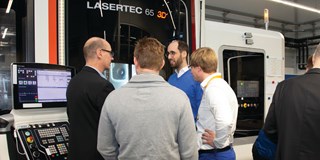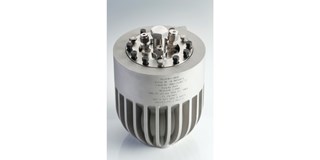^ The heart of the AM Center.
Article By Lucien Joppen
___
What started with two printing machines in a basement has evolved into an Additive Manufacturing Center (AMC) with state-of-the-art equipment and professional, 3D-manufactured parts. In November 2019, BASF opened the AMC which specializes in producing unique parts and manufacturing special alloys.
Florian Bechtold, team leader additive manufacturing at BASF, greeted Valve World magazine at the premises of the AMC on the gigantic chemical complex, the largest Verbund-site worldwide, in Ludwigshafen, Germany. Since the official opening, Florian has also welcomed a large amount of BASF colleagues who were curious to see what the AMC can do for them.
“The AMC only works for BASF”, Florian explains, “so I can understand they are anxious to learn from us. The AMC in turn also should be interested in the business as they are our customers.” A short visit of the AMC, which is in the startup phase, reveals that it applies two major AM-technologies, namely Powder Bed Fusion and Laser Metal Deposition, to equipment part manufacturing. “We design and fabricate metal objects, mostly based on stainless steel and nickel alloys. Also, our business units require equipment parts that are made from these materials.”
Piping connection
According to Florian, the AMC focuses on the design and production of unique parts. These are not copies of existing parts but carry improved design features that should facilitate a more efficient and effective way of producing chemicals.
“We have designed various alternative parts that have been certified according to the Pressure BASF adopt AM as a technology with a high-potential Equipment Directive and taken into production”, Florian says. “A telling example is a U-shaped 180 degree jacketed pipe bend which can be used as a piping connection with an inner part for the medium – to withstand operating pressures up to 325 bar – and a jacket for temperature regulation. These parts are normally manufactured by bending a straight piece of pipe in a forge and by welding the jacket in segments around the high-pressure bend. With our 3D-printed design, we can manufacture the 180 degree bends in one production step and with the freedom to enlarge the cooling/heating channel, allowing for more precise temperature regulation.”
When asked about the trajectory behind the development of these parts, Florian is happy to oblige. Usually, the business requests a 3D-printed part. “They know best which equipment (parts) could be improved. We discuss which options there are, together with a process engineer from the business and a colleague from our research department. It is our job to advise if the production is feasible. After we have determined and CAD-designed a prototype, we produce a scaled-down version for lab testing. If these tests are to everybody’s satisfaction, we produce a fullscale part that needs to be tested and could be certified.”
Impact
In the past year, the team has already produced more than a 1000 parts, one miniseries but mostly has produced unique, single parts. This outcome was mainly achieved using Powder Bed Fusion. These machines allow for the production of several items simultaneously. This capability is not a luxury as most items need at least a week (24/7) to build up an equipment part.
Florian: “Admittedly, these parts need a significant amount of production time. On the other hand, these require less machining as the contours of the parts are well-defined, near net shaped and accurately/precisely manufactured in the PBF-machine. Regardless of the production process (PBF or LMD), these parts need to be heated in a furnace to relieve residual material stresses.” It can be expected that AM will have a growing impact on BASF’s processing equipment – and its output – in the years to come, given the investments in the AMC.
AM Autoclave
Certification will be crucial for additive manufacturing to become a mainstream technology. The Technical Inspection at BASF SE in their role as Notified Body (user inspectorate) has now certified an additively manufactured autoclave as pressure equipment for the first time.
This equipment conforms to the European Pressure Equipment Directive (2014/68/ EU). Within the scope of this Directive, the autoclave made from austenitic stainless steel (operating pressure = 225 bar) meets the Category III requirements.
Therefore, BASF is the first company to execute a certification process, including a procedure qualification for a piece of 3D-printed pressure equipment. In the future, safety-relevant parts, which cannot be manufactured using conventional methods, will be designed, manufactured and quickly put into operation at BASF using this process.
An autoclave is a container in which a reaction between two or more chemical components is activated through the targeted use of temperature and pressure. The equipment, which was manufactured through Power Bed Fusion, consists in this case of corrosion-resistant austenitic stainless steel. Compared to conventionally produced autoclaves, additive manufacturing provides further benefits when designing complex geometric shapes.
This autoclave, for example, features a more than two-meter-long interior channel for the tempering fluid which winds around the container wall. Thus, the new design enables faster temperature cycles to be achieved, better regulation of even temperature distribution, as well as the tempering of the component.




